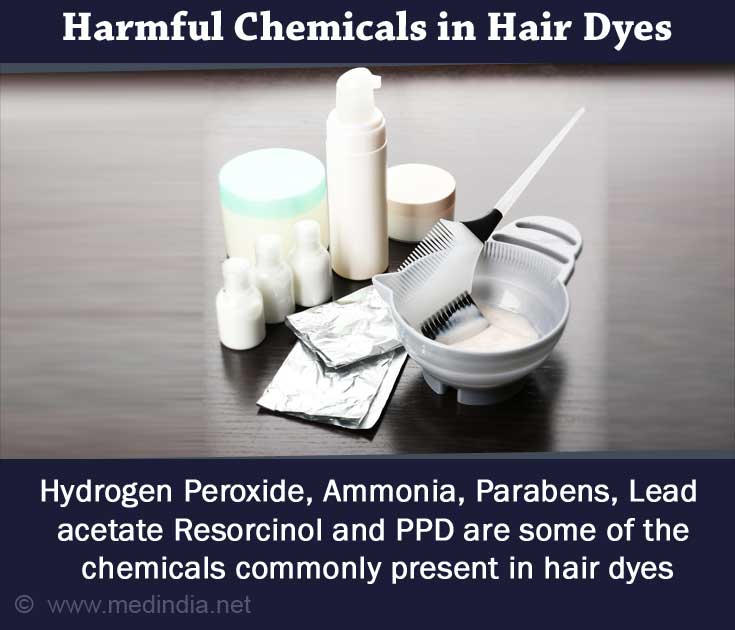- Hair Dyes - (http://www.cancer.org/cancer/cancercauses/othercarcinogens/intheworkplace/hair-dyes)
- Does hair dye cause cancer? - (http://www.cancerresearchuk.org/about-cancer/cancers-in-general/cancer-questions/does-hair-dye-cause-cancer)
- Hair dye could cause cancer - and brunettes are at greater risk - (http://www.dailymail.co.uk/health/article-18662/hair-dye-cause-cancer--brunettes-greater-risk.html)
- Hair Dyes and Cancer Risk - (https://www.cancer.gov/about-cancer/causes-prevention/risk/myths/hair-dyes-fact-sheet)
- Hair Dyes - (http://www.fda.gov/cosmetics/productsingredients/products/ucm143066.htm)
- Saitta P et al. Is There a True Concern Regarding the Use of Hair Dye and Malignancy Development? A Review of the Epidemiological Evidence Relating Personal Hair Dye Use to the Risk of Malignancy. J Clin Aesthet Dermatol. 2013 Jan; 6(1): 39-46.
What are Hair Dyes?
Hair dyeing is the practice of changing one’s hair color to cover grey hair, for a more fashionable or a funky hip hop look. Hair dyes are used extensively by adult men, women and even youngsters to improve their looks dramatically. Streaked hair, multicolored hair, unusual hair shades have always managed to grab our attention. The development of synthetic chemical hair dyes can be traced to around 1860 with the discovery of PPD [paraphenylenediamine].
Hair dyes contain several chemicals, which often raises the concern whether they can cause cancer. Several studies have been conducted in the past to check for any such association. Countries like the United Kingdom and Japan have banned many brands of hair dyes containing chemicals known to cause cancer. However they remain freely available in other countries.

What are the Types of Hair Dyes?
Types of hair dyes include the following:
- Plant Based Natural Hair Dyes: These include henna [lawsonia inermis], indigo, black walnut shells, turmeric, senna, amla, katha, and red ochre.
- Chemical Hair Dyes: These contain different chemicals which impart a specific color to the hair. They come with a shade chart with colors ranging from blonde to darker shades.
- Combination of Natural and Chemical Dyes: These include henna-based dyes which contain chemicals like PPD in varying proportions.
Chemical Hair Dyes are further classified as:
- Temporary dyes are available as shampoos, rinses and sprays. These usually last for one or two washes. They stain the hair directly and do not penetrate hair shaft. Fewer chemicals are used in such hair dyes. Hence, these can be considered safest option.
- Semi Permanent dyes last for 5 to 10 washes. These hair dyes partially penetrate the hair shaft. They contain more chemicals which result in greater chances of toxicity.
- Permanent hair dyes penetrate into hair shaft and give a color that lasts for months.
Which are the Chemicals Contained in Hair Dyes?
Some of the chemicals commonly present in hair dyes include the following:
- PPD [paraphenylenediamine] - PPD is used in dyes for darker shades and is made from coal tar. It can cause skin ulceration, headaches, brittle hair, redness and itching of scalp.
- Hydrogen peroxide - Hydrogen peroxide strips off the natural hair color before applying hair dye. It changes the hair structure and makes the hair brittle.
- Ammonia - Ammonia opens up the outer layer of the hair so that dyes can penetrate inside the hair. It is an irritant to the eyes and skin and also causes breathing difficulties.
- Parabens - Methyl and propyl parabens are the most commonly used parabens in hair dyes.
- Lead acetate - Lead acetate is used in hair dyes of dark shades.
- Resorcinol - Resorcinol is another ingredient of hair dyes that can cause scalp irritation.

Some harmful ingredients of hair dyes are not used in countries like the US and UK. However, they may still be used in hair dyes in other countries. Therefore, it would be a good idea to check your hair dye for these ingredients and avoid it if it contains any of these:
- 4-methoxy-m-phenylenediamine 2,4-diaminoanisole
- 2, 4-methoxy-m-phenylenediamine sulfate 2,4-diaminoanisole sulfate
- 4-methoxy-m-phenylenediamine (4-MMPD)
- 4-chloro-m-phenylenediamine
- 2,4-toluenediamine
- 2-nitro-p-phenylenediamine
- 4-amino-2-nitrophenol
- 2,3-Naphthalenediol
- Solvent Red 1 [Cl 12150]
- Acid Orange 24 [Cl 20170]
- 4 Hydroxyindole
Do Hair Dyes Cause Cancer?
It is not yet clear whether hair dyes can cause cancer. Hair dyes contain a variety of chemicals, therefore a common statement about the health risks of hair dyes cannot be made. The risk of cancer may be slightly higher in those who come in contact with hair dyes regularly like hair dressers rather than those who get their hair dyed occasionally.
Several hair dyes have been studied for their risk for cancers like blood cancers (non-Hodgkin’s leukemia) and bladder cancers. While some studies indicate an increased risk for cancer, others have not been able to find a definite association. The risk of cancer appeared higher with earlier formulations available before 1980 than with the currently available dyes. Thus, as a general notion, hair dyes are currently thought to be non-carcinogenic in humans.

What are the Other Side Effects of Hair Dyes?
- Other side effects of hair dyes include the following:
- Allergic reactions especially on face and upper part of chest and back
- Itching of scalp
- Dryness of hair
- Itching and redness of skin
- Eye irritation
- Throat irritation
- Skin pigmentation
- Lung irritation
- Hair loss

What Precautions Should I Take if I Use Hair Dyes?
Even though it is not definitely proved that the currently available hair dyes cause cancer, some precautions could help you to be safe:
- Wear gloves to prevent contact with chemicals and their absorption into the body. This is particularly essential for hair dressers and barbers who handle chemical hair dyes for long durations
- Reduce the frequency of application of chemical hair dyes
- Use temporary or semi-permanent hair dyes as these contain fewer chemicals
- Age gracefully. Accept the natural hair color and avoid chemical-based hair dyes
- Teach youngsters and adults about the long-term harmful effects of dyes
- Use hair-friendly natural products that along with coloring hair make the hair strong and healthy.
- People already at a high risk of developing non-Hodgkin’s cell lymphoma may benefit by avoiding dyeing their hair.
- Eyebrows and eyelashes should not be dyed since the dye can affect the eyes
- Darker colors may cause higher risk and therefore should be avoided

The government should also take adequate steps to ensure that harmful substances in hair dyes are banned so that they do not reach the consumer.







